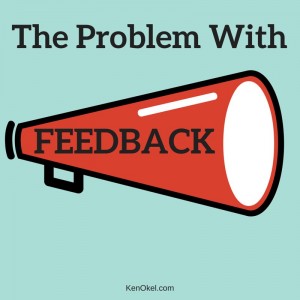 If you’re a leader, you may find yourself challenged in how to effectively give feedback to your team. Do it well and you strengthen you organization. If you deliver feedback poorly, you’ll become Public Enemy #1.
If you’re a leader, you may find yourself challenged in how to effectively give feedback to your team. Do it well and you strengthen you organization. If you deliver feedback poorly, you’ll become Public Enemy #1.
Giving feedback is not a skill that’s taught in school, which is too bad. Let me share with you a funny story of how it can be done incorrectly.
From the first day I met “Greg,” I could tell that he was high strung. Any kind of problem throw him into a panic.
This was a challenge as he worked in the high pressure world of TV News. I could immediately tell what kind of day he was having due to the number of veins that were visible in his face.
I knew that this was not a healthy lifestyle and several years later, I wasn’t surprised to hear that a few years after I left the station, all the stress Greg carried inside had produced a mental and physical breakdown.
Greg took time off from work to get help from medical doctors and mental health professionals. I was happy to hear that he was taking steps to improve himself.
I asked my former colleagues for an update on Greg, version 2.0. This produced laughter.
His coworkers told me that while he was more relaxed and able to cope with stress, all of his treatments had made him a bit of an annoying know-it-all.
During his recovery, he had learned a great deal about coping skills and human behavior. He not only embraced these valuable techniques but would forcefully share them with anyone who breathed.
Tell Greg that you were having a bad day, then he’d give you a ten minute sermon about what you were doing wrong in your life. The feedback was mostly unsolicited and could be generated by a simple comment like, “I hate rain.”
While the information Greg had learned could be useful to all, his delivery or bedside manner was poor. He went from being stressed out all the time, to telling people why they shouldn’t be stressed out all the time.
As you might guess, after a short honeymoon, many decided it was best to avoid Greg.
In this example, you have a person who has good information but poor delivery. If you struggle with giving feedback, then you should consider these concepts:
Structure
Is there a time or a process when you can share feedback with your team? When you deliver feedback in a random fashion, there’s a good chance that it either won’t be heard or will be misinterpreted.
Coaches yell at their players during a game but when they really need to get an important point across, they call a timeout. Can you create a similar experience where you and the other person are able to 100% focus on your discussion? This doesn’t happen in a hallway or at 4:58 p.m. on a Friday.
Control the Message
While Greg had learned some useful information, he treated it like a one-size fits all prescription. In his mind, any problem could be solved with what he had learned.
When delivering feedback, make sure you’re aware of all of the variables in the situation. Just because one person experienced things one way, doesn’t mean that everyone else will. For instance, two people can visit the same park and have vastly differing experiences based on their tolerance for noise, crowds, and insects.
Do your homework to make sure that you’re helping the person and not just spouting off a generic tip.
Have a Next Step
Feedback should be part of a journey where someone was doing something poorly, learned of the problem, received guidance, and then found a long term solution. Make sure that your advice includes more than just an acknowledgement of something done wrong.
This important step, opens the door to growth. It would be like if a coach just told an athlete that he was hitting the ball the wrong way but never demonstrated the right way. If the lesson wasn’t totally grasped, the coach wouldn’t just say, “You’re doing it wrong,” for the second time. Additional information would be given to the athlete to help improve the performance.
Conclusion
Effective feedback for employees should be part of a well thought out process.






